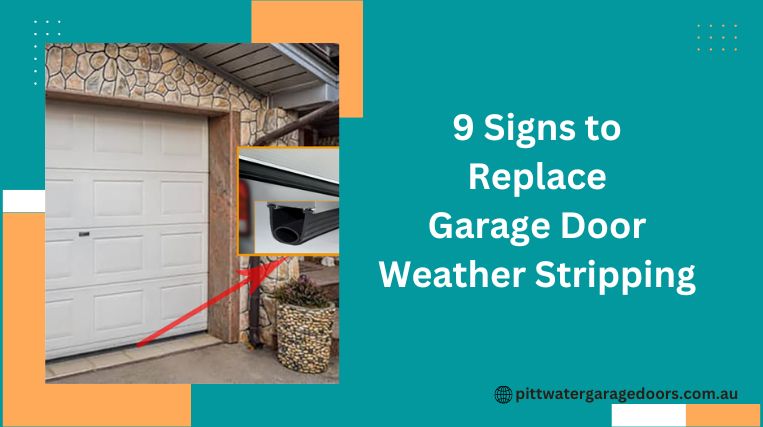Garage doors play a crucial role in protecting our homes and belongings, but often, the weather stripping goes unnoticed until problems arise.
Living in Sydney’s Northern Beaches means facing the coastal elements, making well-functioning weather stripping essential for garage doors.
In this guide, we’ll explore nine signs that indicate it’s time to replace your garage door weather stripping, ensuring optimal protection and energy efficiency for your home in Sydney’s Northern Beaches.
Table of Contents
9 Signs to Replace Garage Door Weather Stripping
Garage door weather stripping can be damaged for various reasons. Below, we have mentioned several signs to identify whether your garage door weatherstripping has been damaged and whether it’s time to replace it.
1. Visible Damage
Visible wear and tear on weather stripping, such as cracks, tears, or fraying along the edges of the material, is often caused by exposure to sunlight, extreme temperatures, or regular usage over time.
Addressing these issues promptly is crucial to maintaining the effectiveness of the weather stripping.
Failure to do so can lead to further deterioration, allowing drafts, moisture, and pests to enter the garage, compromising its insulation and security.
2. Drafts or Air Leaks
Drafts around your garage door indicate that the weather stripping is no longer effectively sealing the gap between the door and the frame, often due to wear and tear or damage over time.
These air leaks caused by ineffective weather stripping can significantly impact your home’s energy efficiency and comfort.
They allow cold and hot air to circulate in winter and summer, increasing heating and cooling costs and creating uncomfortable temperature fluctuations.
3. Moisture or Water Intrusion
Moisture ingress through the weather stripping signifies deterioration, compromising its sealing ability against the elements, leading to gaps or cracks.
This degradation can result in various damages, including mould growth, rotting of wooden structures, corrosion of metal components, and potential water damage to belongings stored in the garage, posing financial losses and health hazards.
4. Increased Energy Bills
Deteriorating weather stripping leads to gaps around the garage door, allowing cold or hot air to enter or escape, causing the HVAC system to work harder to maintain desired temperatures.
This increased workload results in higher energy consumption and elevated energy bills.
Proper insulation, facilitated by intact weather stripping, is crucial for maintaining energy efficiency within the home.
By addressing weather stripping issues promptly, homeowners can reduce energy waste and mitigate the impact on their monthly utility expenses.
5. Difficulty in Opening or Closing the Door
Worn weather stripping can lead to misalignment or friction between the garage door panels and the frame, making it challenging to open or close smoothly.
This increased resistance can strain the door mechanism and motor, potentially causing premature wear and tear.
Difficulty in operating the garage door not only poses inconvenience but also raises safety concerns. It may result in unexpected closures or partial openings, posing a risk of injury to individuals or property damage.
Addressing worn weather stripping promptly is essential to maintaining safe and efficient garage door operation.
6. Pest Infestation
Damaged weather stripping creates gaps and openings around the garage door, providing easy access points for pests like rodents, insects, and spiders.
These openings allow pests to enter the garage and potentially infiltrate your home, leading to infestations and property damage if left unchecked.
Pest infestations in the garage pose various risks and health hazards, including contamination of stored items, damage to wiring and insulation, and the spread of diseases carried by rodents and insects.
Additionally, pests can cause structural damage to the garage and compromise its integrity over time, leading to costly repairs.
7. Cracks or Gaps in the Weather Stripping
Cracks or gaps in the weather stripping are clear signals of deterioration, compromising its ability to effectively seal out elements like moisture, drafts, pests, and debris.
Neglecting these issues can worsen the problem, leading to further degradation of the weather stripping and potentially impacting the garage door’s functionality and insulation.
Leaving these openings unaddressed can also increase energy costs due to heat loss or gain, creating opportunities for pests to infest the garage space.
8. Excessive Noise
Deteriorating weather stripping often leads to gaps or cracks around the garage door, allowing outside noise to penetrate easily.
As the door operates, these gaps can create friction and cause squeaking or rattling sounds. Addressing the weather stripping can significantly reduce these noises and improve the overall operation of the garage door.
A quiet and smoothly functioning garage door is essential for maintaining a peaceful living environment and preventing unnecessary disturbances, especially during early mornings or late nights.
Additionally, excessive noise from a malfunctioning garage door may indicate underlying issues that could worsen if left unattended, making regular maintenance crucial for optimal performance.
9. Age of the Weather Stripping
Considering the age of the weather, stripping is crucial because as it ages, it becomes less effective at sealing out elements like wind, rain, and pests.
Over time, weather stripping can degrade due to exposure to sunlight, temperature fluctuations, and general wear and tear, leading to decreased efficiency.
Generally, weather stripping lasts 5 to 10 years, depending on material quality and environmental conditions.
It is advisable to inspect the weather stripping annually for signs of wear and replace it if it is cracked, brittle, or no longer provides a tight seal.
Takeaway
Attention to the condition of your garage door weather stripping is essential for maintaining a secure, energy-efficient home environment in Sydney’s Northern Beaches.
By promptly recognising and addressing these nine signs of weather stripping deterioration, homeowners can ensure optimal protection against the coastal elements, prevent energy waste, and avoid potential pest infestations or structural damage.
Regular inspection and weather stripping replacement when necessary are critical for safeguarding your garage and overall property investment.


